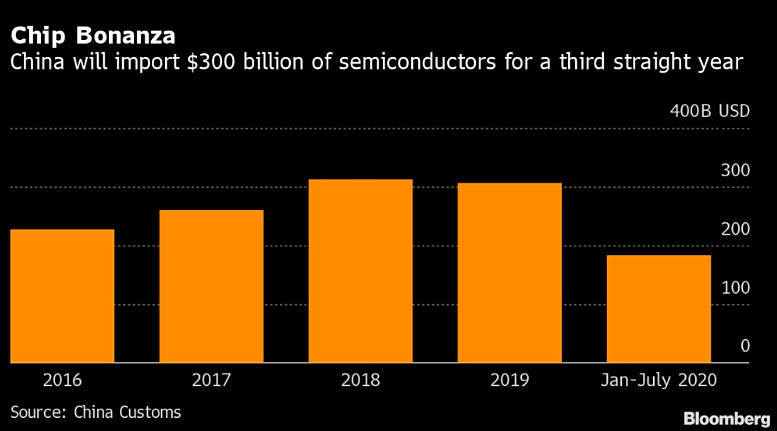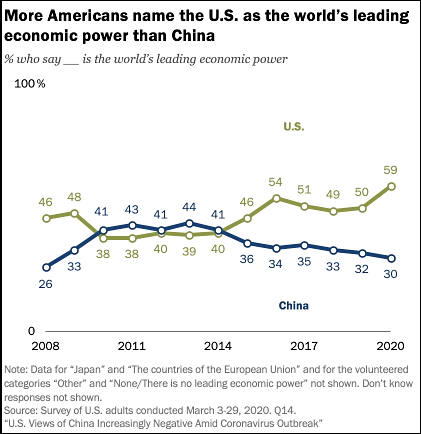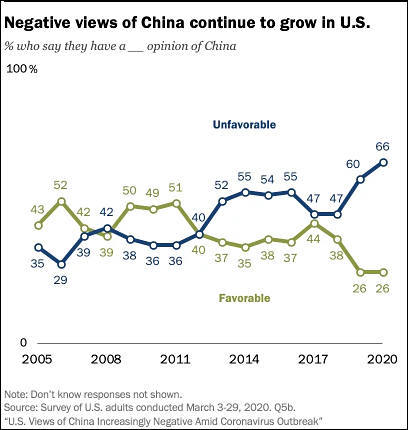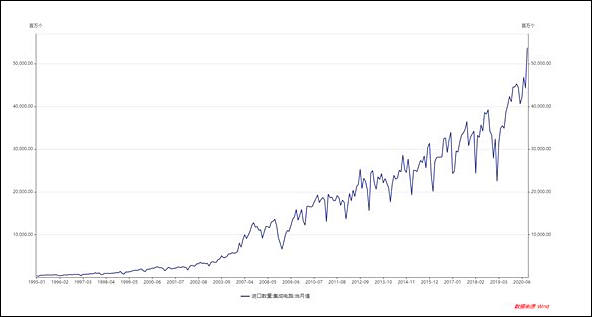
-
Who wants to go into manufacturing nowadays? Nothing but problems! :)
Donald Trump 4 years from now:
HELP! I'm being held captive in an American Sweatshop somewhere in Kansas. Mike Pompeo, Peter Navarro and I went to this rally for our Great American Farmers, but they turned on us! We were tossed in a pickup truck. Now we're on a Soybean picking Chain Gang. Boy, were we suckers! At night, we don't sleep. We're forced to make Halloween and Christmas decorations to compete with China! I'm writing this note on a soybean. If a guy in China with good eyesight can read this and understands English, call Amnesty International or something. Don't call a Trump Hotel, the staff hates me!
-
Concerns are growing about whether China-based memory chipmakers ChangXin Memory Technologies (CXMT) and Yangtze Memory Technologies (YMTC) will be next in line of US sanctions.
-
Semiconductor Manufacturing International (SMIC) has seen several of its suppliers for raw materials, equipment, parts and components start following export restrictions imposed by the US government on the Chinese foundry house, according to the company.
Firm can stop manufacturing quite soon, within 4 months.
-

US plan to cut Chinese semiconductors import by 3-4 times in 2021.

 sa14903.jpg777 x 431 - 36K
sa14903.jpg777 x 431 - 36K -
5 years before USA can become somehow independent from chinas manufacturing in all lithographic processes.
-
Trade war and human rights
Nearly 40 mainly Western countries criticized China’s treatment of minority groups, especially in Xinjiang and Tibet, on Tuesday and expressed grave concern at the impact of its new national security law on human rights in Hong Kong.
The 39 countries also urged China in a joint statement read at a meeting of the General Assembly’s human rights committee, “to uphold autonomy, rights and freedoms in Hong Kong, and to respect the independence of the Hong Kong judiciary.”
but
Their statement was immediately followed by a statement from Pakistan on behalf of 55 countries opposing interference in China’s affairs when it comes to Hong Kong. It said the territory is part of China, and the national security law ensures China’s “one country, two systems” policy on Hong Kong is enduring.
Cuba followed with a statement on behalf of 45 countries supporting China’s counter-terrorism and deradicalization measures in Xinjiang. It said measures taken by China in response to threats of terrorism and extremism were carried out within the law to safeguard the human rights of all ethnic groups in the province.
-
US now attempts to win trade war with domestic media machine



 sa14952.jpg421 x 434 - 34K
sa14952.jpg421 x 434 - 34K
 sa14951.jpg408 x 430 - 30K
sa14951.jpg408 x 430 - 30K -
TruAnalog Speakers: http://www.trueanalog.com
-
After four years of relentless effort by President Donald Trump to push back against China, his campaign reached new heights (or lows) Friday when he sought to ban new downloads of WeChat, China’s ubiquitous messaging and payments app, and the wildly popular video-sharing app TikTok.Nevertheless, the final scorecard is already in: On just about every metric that matters, China is ahead. At every turn, Trump seems to have been outplayed and outsmarted throughout the global trade war that began shortly after he took office.Consider the trade balance, which Trump seems to regard as the most important measure of success in his effort to get China to play by global trading rules.China’s trade surplus with the U.S. has grown almost 25% since the start of the Trump presidency, exceeding $300 billion on an annualized basis, writes Jim McCormick of NatWest Markets. And China is nowhere near on track to meet its target of increasing imports from the U.S. under the partial deal (also called “phase 1”) to end the trade conflict, the signal accomplishment of Trump’s tariff tit-for-tat.
Trump’s assaults on WeChat and TikTok are a distraction; there are better ways to mitigate the national security risk Chinese companies may pose by gaining access to U.S. personal data. In any case, lashing out at Chinese tech companies will only slow, not derail, Beijing’s efforts to dominate the 21st century economy.Take the race to develop batteries, a key to the future of transport, defense and other industries. By 2025, China will have battery facilities with maximum production capacity of about 1.1 terawatt-hours’ worth of cells annually, almost double the rest of the world combined. The White House response? So far, inertia, said Cathy Zoi, chief executive officer of charging-network operator EVgo, and an assistant secretary at the U.S. Department of Energy under President Barack Obama.The net result of Trump’s efforts to decouple the U.S. and Chinese economies is to push China even further toward self-sufficiency, a strategy set to be enshrined in China’s new five-year plan at a meeting of the Chinese Communist Party Central Committee next month. -
China imported 53.72 billion integrated circuits in September, with a total value of 256.93 billion yuan. This is another record high for China's single-month imports of integrated circuits after July, according to data released by China's General Administration of Customs on October 13.


 sa15082.jpg592 x 317 - 19K
sa15082.jpg592 x 317 - 19K -
The Cotton Australia and the Australian Cotton Shippers Association, in a joint statement on Friday, said that China's National Development Reform Commission has been recently "discouraging" their spinning mills from using Australian cotton.
Slow movements.
-
Japan not joining U.S. plan to exclude Chinese firms from telecoms networks -Yomiuri
TOKYO, Oct 16 (Reuters) - Japan informed the United States that Tokyo, at the moment, won’t participate in Washington’s plan to exclude Chinese firms from telecommunications networks, the Yomiuri newspaper reported on Friday, citing several sources. Japan will take its own steps to respond in case there are worries over security issue, while Tokyo will cooperate with the United States, the paper said. -
In reality, Chinese suppliers in telecom lost this year totally:
- US and Canada
- Australia and NZ
- UK
- Almost all EU (some countries did not tell this formally yet)
- Almost all Eastern Europe countries (as they are controlled by US)
- Middle east countries
-
Some countries may be just stalling for as long as possible, as it will cost billions to rip out and replace current Huawei Equipment. Billions nobody wants to spend. By that time, China and Mordor maybe installing 6g :)
OTTAWA — Sep 14, 2020 Canada is signalling it might not compensate major telecommunications providers if the federal government bans equipment made by China’s Huawei from 5G networks, setting up a potential fight over a bill that could hit $1 billion (US$758 million).Australia is shocked – shocked – to discover that its main supplier of telecom equipment, Ericsson, depends on Chinese equipment from Panda Electronics, a Nanjing-based manufacturer that appears on the Pentagon’s latest list of Chinese companies linked to the People’s Liberation Army (PLA). The supposedly incendiary revelation, by now widely reported in the Australian press, came as the US Defense Department named Panda as being "owned by, controlled by or affiliated with China's government, military or defense industries.”Panda Electronics, it turns, has a joint venture in China with Swedish giant Ericsson, a major supplier of equipment used by Australian telecom network providers Telstra and Optus. Those tie-ups means Panda, by at least one degree of separation, is and will be involved with Australia’s pending 5G rollout. -
Do not worry so much, no one know if Huawei will make it past next 12 months (most probably it'll break into many small companies who will try to survive), same is true for SMIC.
Fun thing is that Chinese companies lost lot of 4K TVs market and now repeat same error on 8K TVs market. They just not producing stable normal product on time. Either it is some exhibition thing, or it is super low level stuff (that makes 80% of their sales).
-
Japan already eliminates Chinese vendors from their telecom networks. Softbank is the one that uses Chinese vendors and they already said they will stop doing so with 5G. NTT Docomo never uses Chinese gears in any case, and same goes with KDDI. So Japanese government does not need to edict any ruling here, they only need to tell Japanese companies unofficially, as they always do.
-
Canada hasn't officially banned Huawei yet, although the two telecoms Bell and Telus who were continuing their relationship with Huawei had to drop them. Governments around the world have a difficult balancing act, obey the US to ban Chinese tech and pressure from China to keep the market open to trade. Ask Merkel about Nord Stream! ( US vs Mordor trade ) Although Japan and South Korea don't really need Chinese equipment anyways. Even The US Dept of Defense and other federal agencies which use Chinese equipment have found it hard to implement the ban:
And it bans federal contractors from using such equipment. Now, the term “used” doesn’t have any definition in the statute, right? And so there’s some some ambiguity and if you walk through an airport and catch an airplane and the surveillance cameras in that airport are Huawei equipment, are you using that equipment for your official contract actions? Well, by one stretch of definition, you are, by another definition, well, that’s not using – you don’t have any choice. You got to fly on the airplane, you got to walk through the airport.https://federalnewsnetwork.com/contracting/2020/06/us-policy-on-huawei-leaves-contractors-in-a-bind/
Ban on Chinese products starts today despite confusion over acquisition rule
Trump ban on Chinese-made drone parts increases risk wildfires
According to an internal memo, the U.S. Department of the Interior’s decision not to buy more drones with Chinese parts has made it more difficult to fight wildfires. The memo exposes one consequence of the Trump administration’s crackdown on Chinese tech, which includes Chinese-made drone parts.https://dronexl.co/2020/08/31/trump-ban-chinese-made-drone-parts-risk-wildfires/
-
Xiaomi, OPPO reportedly stockpiling Japanese parts and increasing production 2020-10-18 17:30:24 GMT+8
Xiaomi, OPPO reportedly stockpiling Japanese parts and increasing production significantly Japanese electronic parts makers received large stockpiling orders from Chinese handset makers such as Xiaomi, OPPO, and Vivo to fill the loss of orders from Huawei, according to Nikkei Asia.Huawei's orders were suspended after US sanctions took effect on September 15. Still, a surge in demand from rivals such as Xiaomi, OPPO, and Vivo filled the gap, according to the report on Friday. Some customers are looking for Japanese technology, fearing that the US could extend the ban to other Chinese companies.Total smartphone shipments are expected to fall for the fourth consecutive time in 2020, according to market researcher IDC. A 10 percent decrease to 1.2 billion units, due in part to Covid-19. However, some manufacturers have more aggressive production plans to fill Huawei's market share.Apple recently announced to its suppliers that it plans to produce 220 million iPhones this year, 10 percent more than it previously expected. Xiaomi and OPPO are looking to seriously ramp up production in 2021, according to several of their suppliers, to reach a goal of 200 million phones each, which is more than half of what they will produce in 2020.Huawei is expected to produce about 190 million phones this year, 20 percent less than in 2019. While Huawei has stockpiles of spare parts to minimize the immediate impact of sanctions, these reserves can only go so far. The company is thought to have about six months' worth of parts, with production expected to fall from the first quarter of 2021.TDK Corporation, a Japanese electronic parts maker, expects other companies to purchase more than Huawei's lost business. An employee of a major Japanese electronic parts maker said, "Orders at the end of September are already at a record high, and some manufacturers are planning to double their production plans for next year."Chipmaker Renesas Electronics Corp. was asked by a Chinese customer to have a non-US engineer redesign a specific product at a factory outside the United States. Zuken, a supplier of circuit board design software, reports growing interest from companies in China and elsewhere in finding alternatives to US-made tools.In addition, suppliers are distancing themselves from the US in order to continue doing business with Huawei. Sumitomo Electric Industries Ltd. has begun using Japanese-made equipment instead of some US equipment to test components for Huawei's base stations. However, one supplier warned that this is a special one-time demand boost that may be adjusted in early 2021. -
It can be nice time to throw out Oppo, Vivo and Xiaomi from EU and some Asian markets.
As all of this firms are even worse than Huawei, especially Xiaomi who are house who hire designers and other firms to assembly and test their smartphones.
-
Despite the Boycott Made in China campaign in India. There are more Chinese smartphones available in the Rs 10,000-20,000 price range in India than non-Chinese ones. This also happens to be the range that half of the Indians surveyed by Counterpoint Research said they would stick to when buying a smartphone. India is also flooded with more Chinese smartphones brands than those from any other country. This means the chances of an Indian buying a Chinese brand is much higher, said the survey.According to another market research firm IDC, nearly 76 per cent of the 32.5 million smartphones shipped to India in the quarter ending March 2020 belonged to Chinese smartphone brands. The same IDC data also showed that four of the five top smartphone brands in India are Chinese. Xiaomi, a Chinese brand, has the highest market share in India, followed by Vivo. At number three is Samsung, the only non-Chinese brand to be in the top five, followed by Realme, and Oppo, both Chinese brands.Even in the refurbished market for smartphones, Chinese brands are among the most popular. Yaantra is a firm that partners with 35,000 re-sellers who buy refurbished phones and sell them to consumers. Yaantra co-founder and CEO Jayant Jha told ThePrint that Xiaomi smartphones sell the most, followed by Samsung, OnePlus and Apple phones. While business has resumed, he said, there hasn’t been any change in consumer sentiment.
-
Vivo has expanded its reach and announced its entry into the UK, France, Germany, Italy, Poland and Spain. The Chinese tech manufacturer has also presented its first European line-up at an online media briefing broadcast from Dusseldorf, Germany.
Will be quite fun to see as BBK brand will be kicked out within next 1-2 years.
-
Be very careful with Huawei!
Company plans to abandon service for most models worldwide (they don't have motherboards and lot of components). It won't be public, but you will be told that you damaged smartphone yourself, also lot of service centers will stop working with Honor and Huawei brands.
Next - company plant totally abandoning Android and moving into their own OS that will require significant apps rewriting. You already can't install up to 40% of most popular apps - and with such move in 2021 (will be automatic other the air update, impossible to go back) it will be much worse.
-
Los Angeles, Long Beach ports see record volumes of container ships from China
Container ships could face further delays at the Ports of Los Angeles and Long Beach in the weeks ahead as the ports struggle to handle record volumes while also maintaining safe working conditions, market sources said on Oct. 7. The Port of Long Beach had an all-time high throughput of 753,081 twenty-foot equivalent units, or TEUs, in July before slightly easing to 725,610 TEUs in August, still up more than 9% year on year. Some of those volumes were displaced to the adjacent Port of Los Angeles, which posted its own all-time high volume at 961,833 TEUs in August. The record volumes compelled some shipowners to switch around their scheduled terminal berths between the two ports depending on which was less congested.But amid the influx of cargoes shipped ahead of China's Golden Week holiday ending Oct. 7, shipowners may have little alternative but to accept delays at North America's two largest ports until volumes begin to taper off. "Vessels can't get unloaded fast enough and reliability is getting tough, putting the whole supply chain under pressure." The freight forwarder said the congestion at the two Southern California container ports is even worse than the crunch in 2018, when shippers scrambled to get ahead of new US import tariffs on Chinese goods. The ports, which handle about 37% of all waterborne US imports and more than 60% of cargoes coming from China, have had to deploy about a third fewer longshoremen and other workers to maintain social distancing protocols during the coronavirus pandemic. -
How Covid-19 helped drive growth Between EU and China
With many airlines grounded due to travel restrictions, the China-Europe freight train service experienced a record peak in demand during the coronavirus pandemic. With a new route now expected between Xi’an and Barcelona, how has the line evolved over the years, and what does its future look like post-pandemic?Freight rates have been on a steady increase lately, reaching record levels during the Covid-19 crisis and putting rail transport under the spotlight. Having witnessed a 41.7% year-on-year increase in cargo rates as a result of coronavirus, Xi’an’s transport hub was quick to open a dedicated channel for trains to continue normal operations and support the economy in early 2020. “Railway transportation’s safety, stability and speed in [recent] years were [noticed] by the majority of customers,” says Boer. “Compared with air and ship transportation, the reliability of railway transportation during the outbreak of coronavirus has been fully verified.”The pandemic indeed offered the New Silk Road rail service the opportunity to take up orders that would usually be destined for ships, roads and aircraft. “Rail is faster, allows for long-distance transportation and solves the problem of undershipment caused by the asynchronous lockdowns [that took place] in countries around the world,” explains Ekaterina Kozyreva, international projects director at the Infrastructure Economics Centre.With planes grounded and restrictions in place at border crossings and ports, the railways have emerged as the ideal alternative for the transportation of cargo, especially medical equipment sent from China to Europe. “Traffic really shifted from roads to rail because roads have a heavy human resource requirement,” she continues. “That’s a weak point because the more staff [there are] the more health checks [there are], while for the railways there is no such problem because there is a locomotive team arriving at the border where it changes, and [then] there’s another locomotive belonging to another country with local staff.” Echoing her words, Boer adds: “During the epidemic, the train [service] stabilised the trade and supply chain between China and Europe, and became the ‘life channel’ for the transportation of epidemic prevention materials.” -
Huawei kicked out from another country
On Tuesday, an announcement from Swedish regulator prohibits operators from using equipment from Huawei and ZTE. The announcement warns operators to eliminate these companies before the spectrum auction that will hold next month.
“Huawei has never posed the slightest threat to Sweden’s cybersecurity, and will never. Excluding Huawei will not make Sweden’s 5G network more secure. On the contrary, competition and innovation will be severely hampered.”
Security has nothing to do with bans. As it total destruction of company that is required.
It is expected that 3 more countries will join Sweden before December.
Howdy, Stranger!
It looks like you're new here. If you want to get involved, click one of these buttons!
Categories
- Topics List23,991
- Blog5,725
- General and News1,358
- Hacks and Patches1,153
- ↳ Top Settings33
- ↳ Beginners255
- ↳ Archives402
- ↳ Hacks News and Development56
- Cameras2,364
- ↳ Panasonic991
- ↳ Canon118
- ↳ Sony156
- ↳ Nikon96
- ↳ Pentax and Samsung70
- ↳ Olympus and Fujifilm100
- ↳ Compacts and Camcorders300
- ↳ Smartphones for video97
- ↳ Pro Video Cameras191
- ↳ BlackMagic and other raw cameras118
- Skill1,961
- ↳ Business and distribution66
- ↳ Preparation, scripts and legal38
- ↳ Art149
- ↳ Import, Convert, Exporting291
- ↳ Editors191
- ↳ Effects and stunts115
- ↳ Color grading197
- ↳ Sound and Music280
- ↳ Lighting96
- ↳ Software and storage tips267
- Gear5,415
- ↳ Filters, Adapters, Matte boxes344
- ↳ Lenses1,579
- ↳ Follow focus and gears93
- ↳ Sound498
- ↳ Lighting gear314
- ↳ Camera movement230
- ↳ Gimbals and copters302
- ↳ Rigs and related stuff273
- ↳ Power solutions83
- ↳ Monitors and viewfinders339
- ↳ Tripods and fluid heads139
- ↳ Storage286
- ↳ Computers and studio gear560
- ↳ VR and 3D248
- Showcase1,859
- Marketplace2,834
- Offtopic1,322




